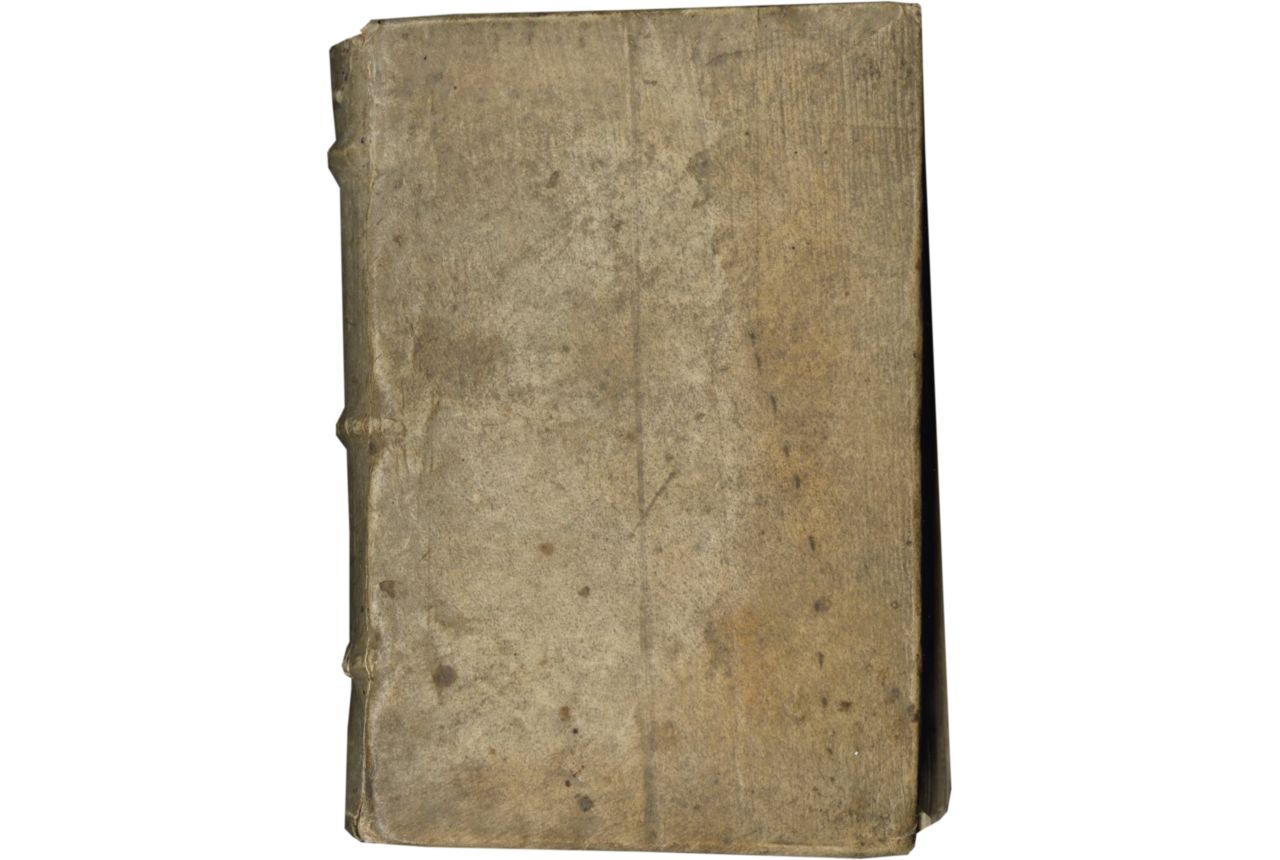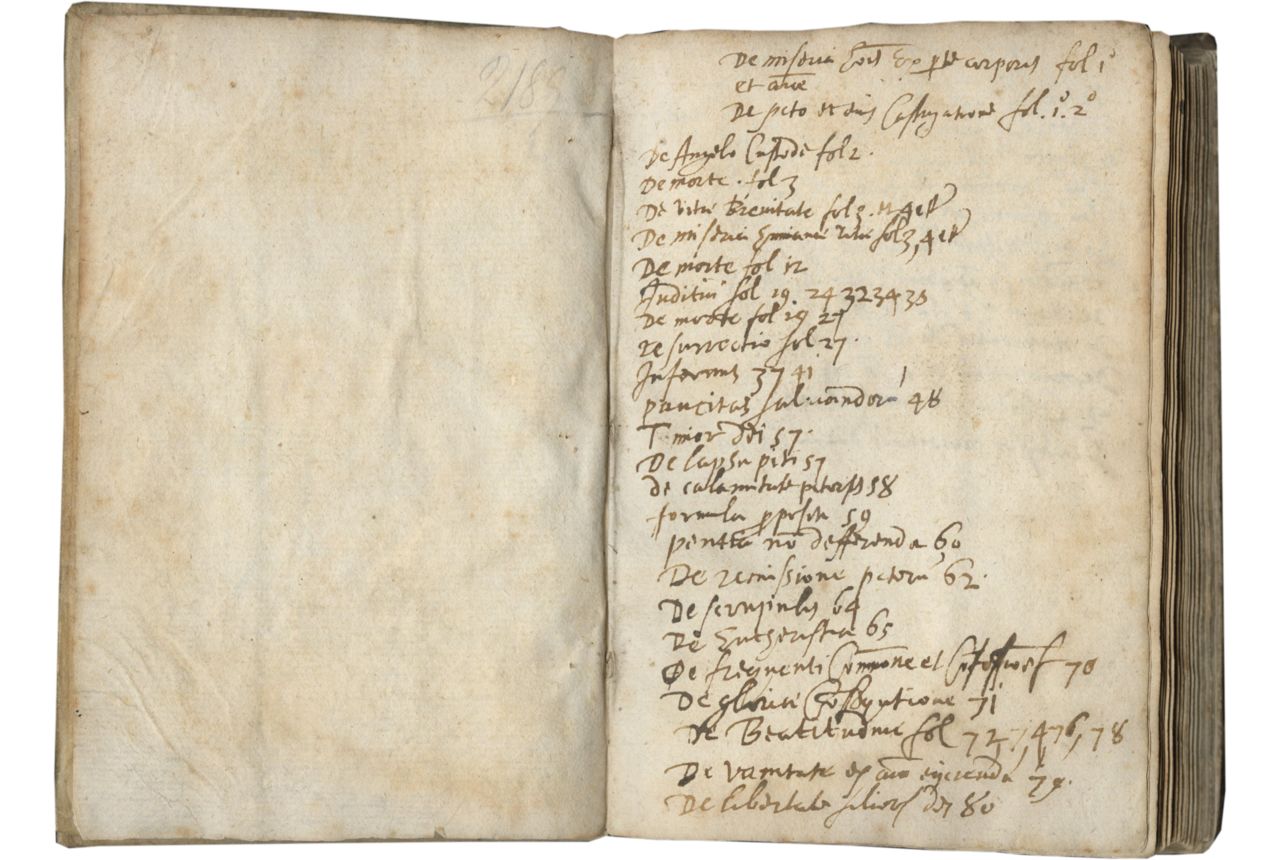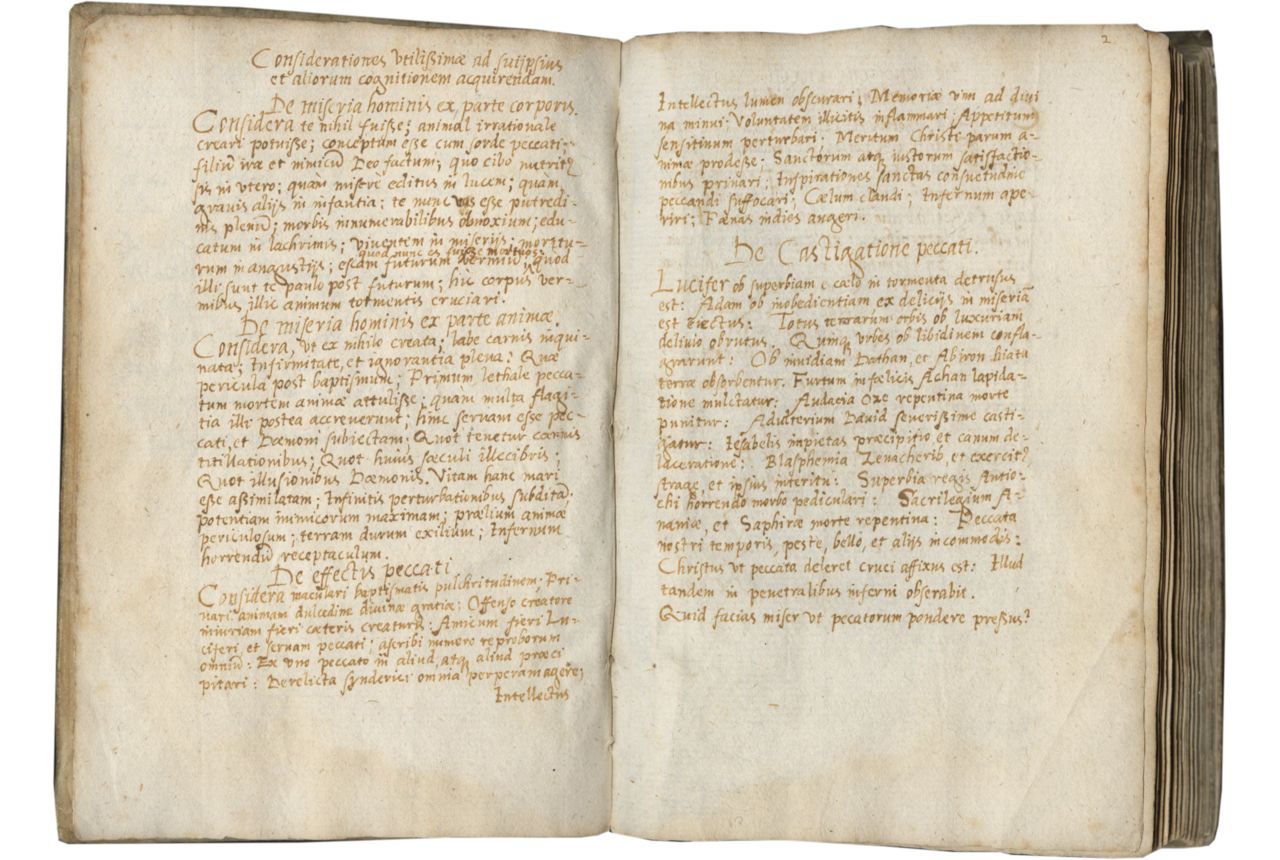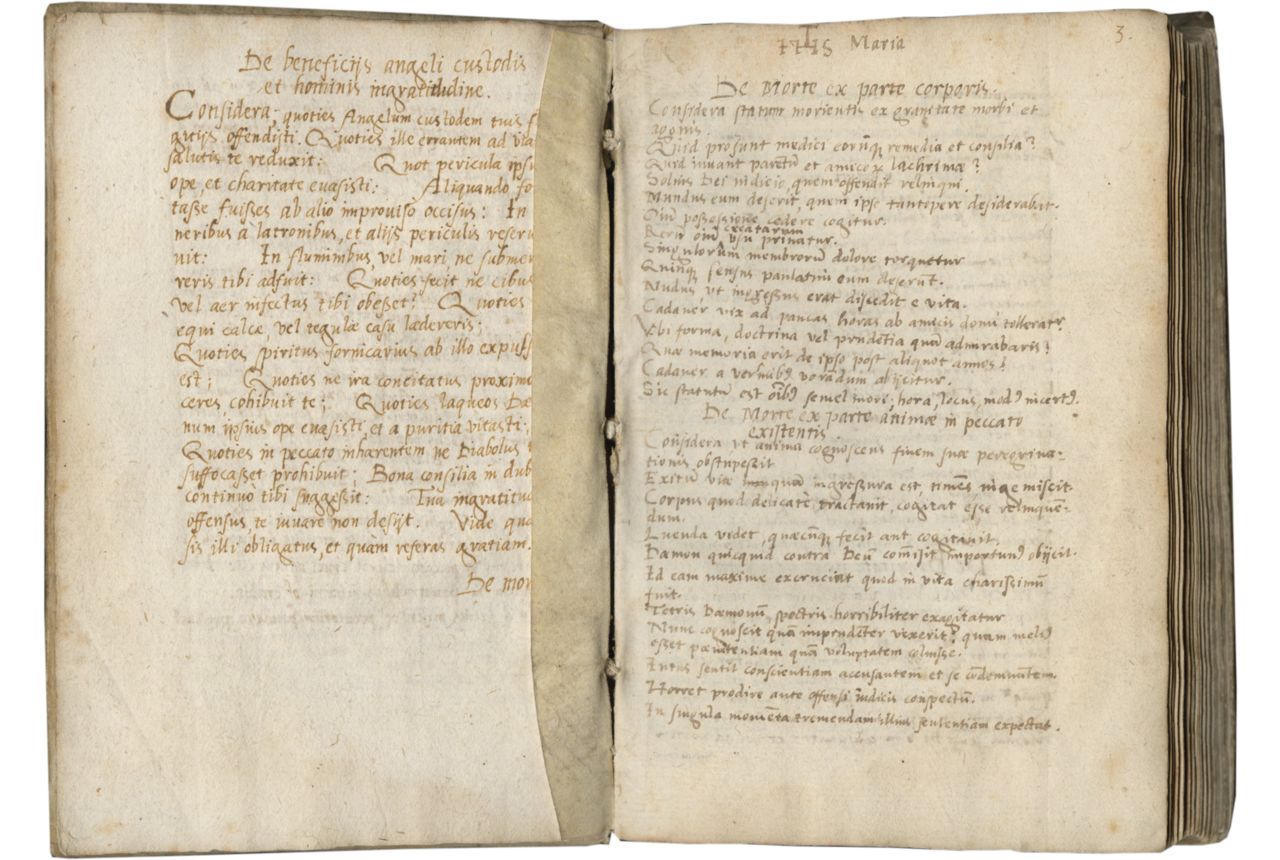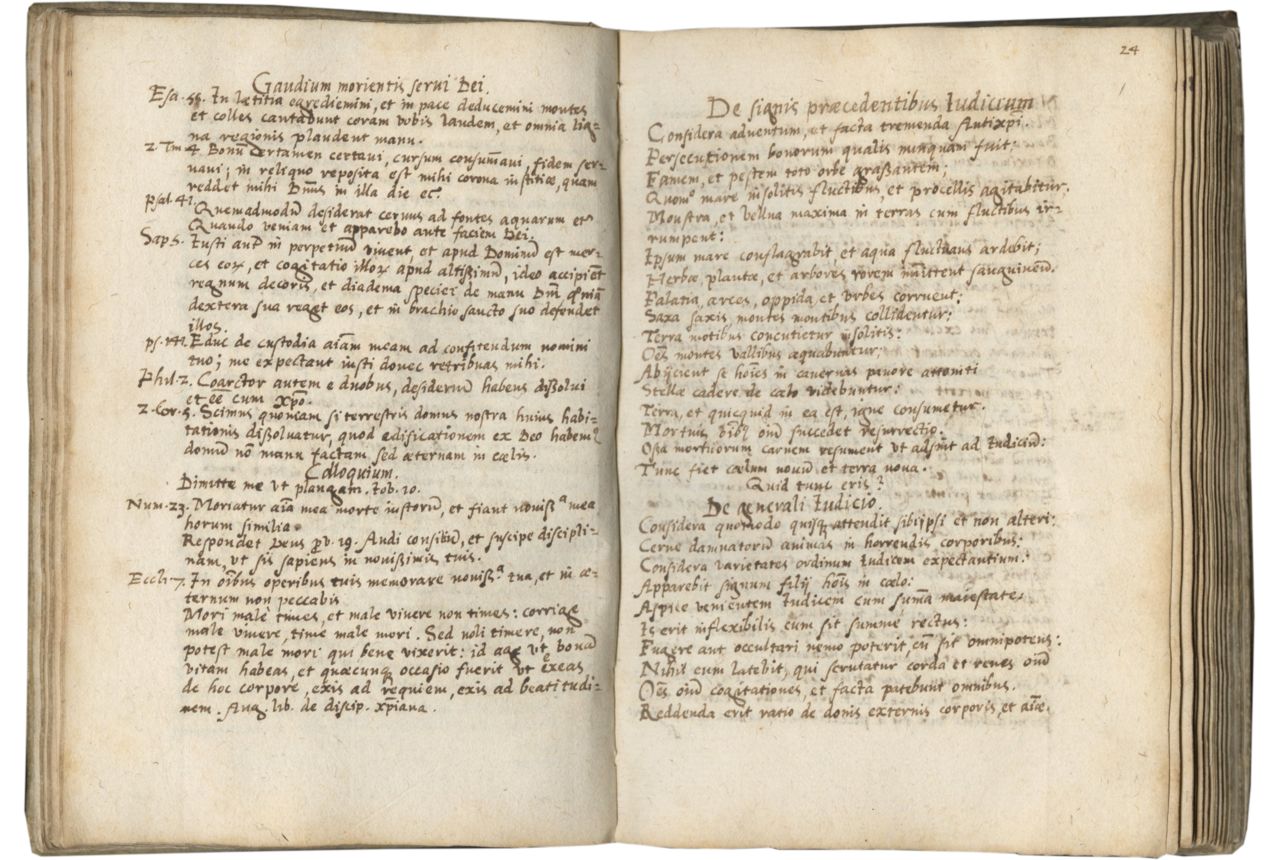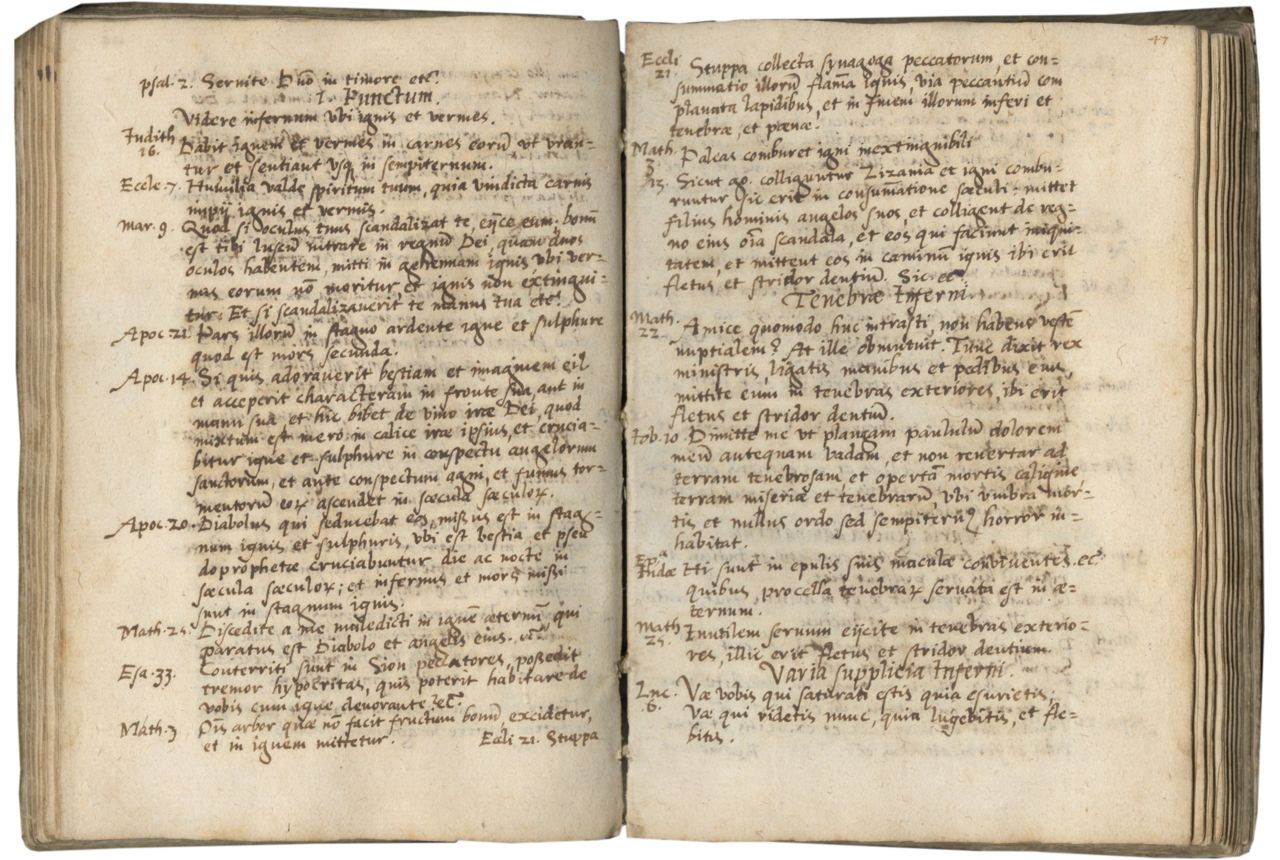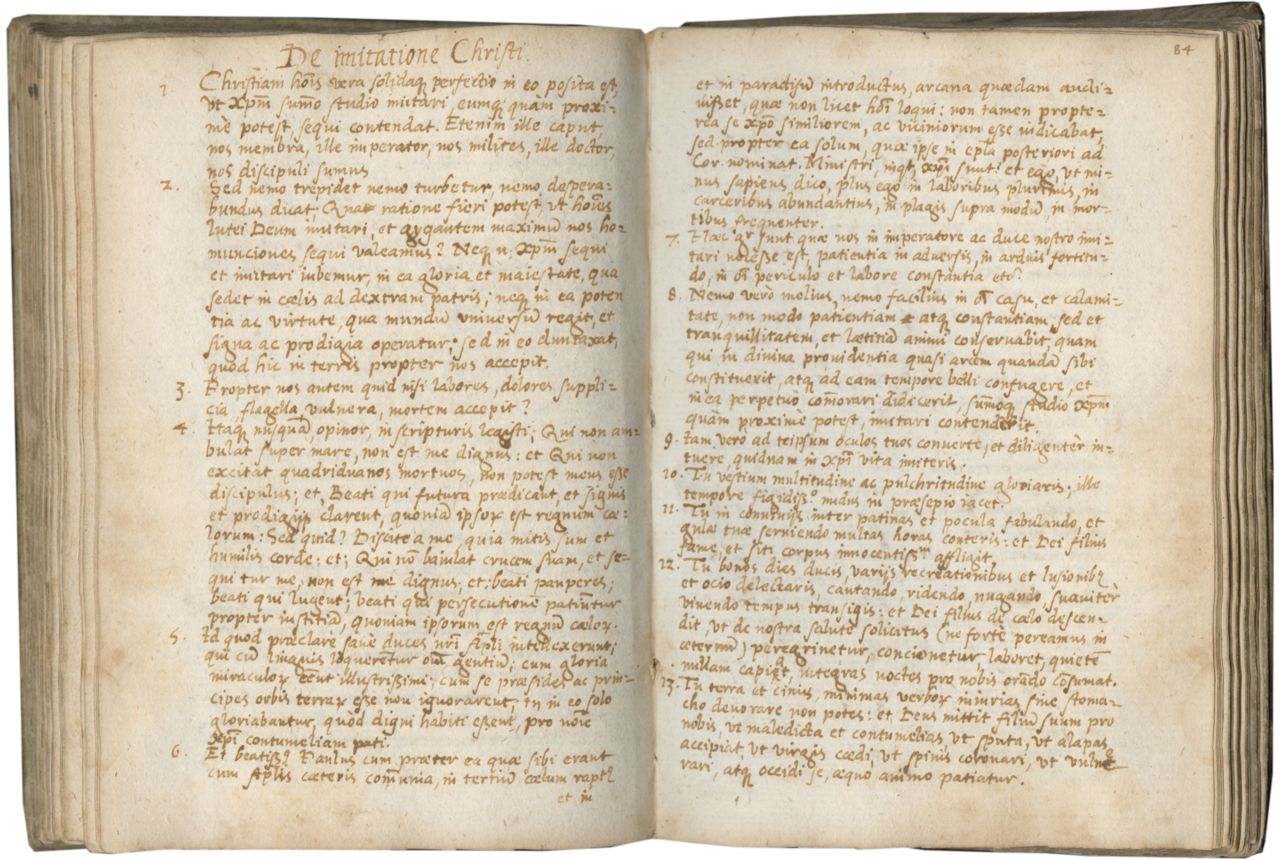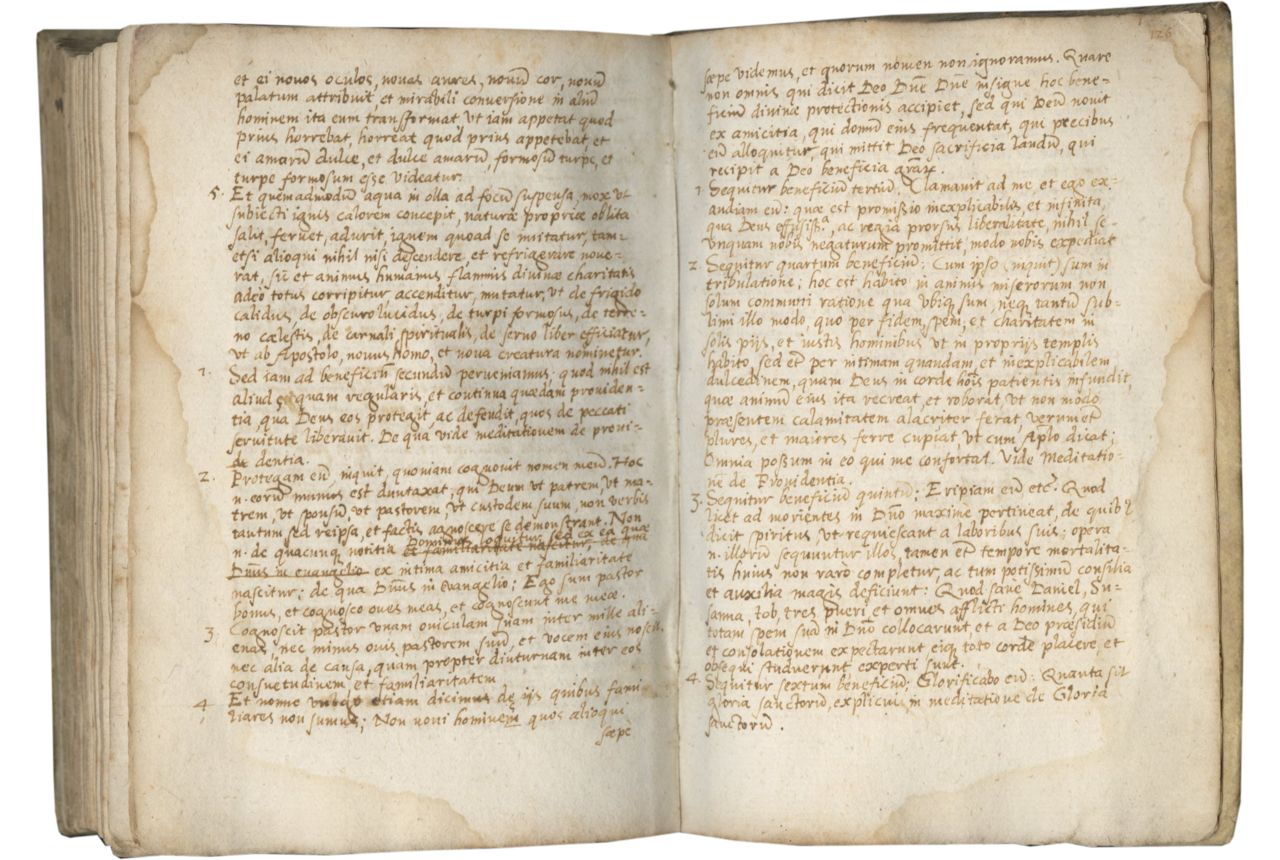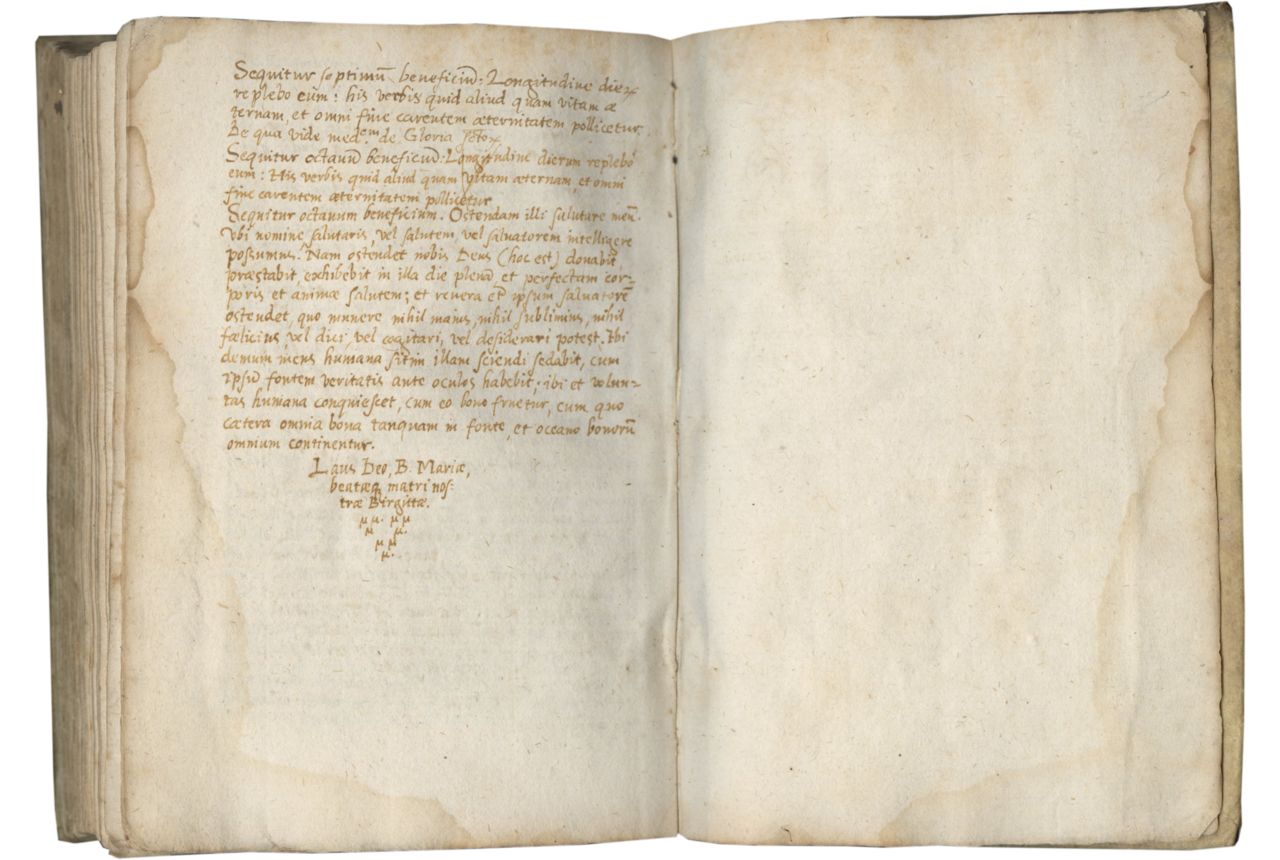i (parchment) + 130 + i (parchment) folios on paper, watermark “pot à une anse” similar to Briquet 12804, Evreux, 1588, Bec-Helloin, 1596), the parchment sheet forming the front and end flyleaves is a reused fifteenth-century notarial document from Normandy (verso of front flyleaf), modern foliation in brown ink, 1-126, with 2 unnumbered leaves in the beginning and 2 at the end integral to quires of the text block, complete (collation i4 ii-v8 vi12 vii8 viii10 ix-xvi8), catchwords on every verso, no ruling (justification c. 113 x 70 mm.), written in brown ink in a small cursive bookhand influenced by humanist script on c. 28-32 long lines, rubrics in brown ink, some small stains and signs of use, but in overall excellent condition. CONTEMPORARY BINDING made in Normandy of a parchment wrapper, spine with three raised bands, stained and worn, but in overall good condition. Dimensions 145 x 95 mm.
A lengthy collection of writings relevant to the religious life compiled by a Jesuit, or perhaps someone studying at a Jesuit college, likely as a personal guide to spiritual growth. Copied in a careful, very legible, script, this manuscript – unstudied and very likely unique – is an important new source for Jesuit spirituality in the early seventeenth century, which warrants careful study.
Provenance
1. The evidence of the watermark (localized to Evreux and Bec-Hellouin) and the binding of this manuscripts points to an origin in Normandy in Northern France. The flyleaves used to protect the text block in its contemporary binding were from a document in French which includes the word “Normandy” (see the verso of the front flyleaf). The manuscript must date after c. 1615 (date of the first edition of Robert Bellarmine’s works), but the evidence of the script and watermark suggest not long after that date.
The sources used, as well as the vocabulary of this spiritual manual, all underline its Jesuit origin. This is almost certainly a unique, personal manuscript, compiled by a Jesuit for his own spiritual journey, or perhaps by a student studying at a Jesuit college. Given that fact, the final words of the manuscript are difficult to interpret: “Praise to God, to the Virgin Mary, and to our mother, Bridget.” How we are to interpret “our mother Bridget,” remains an open question (see below for a discussion of possibilities).
2. Modern booksellers’s notes written on the first unnumbered leaf in the beginning.
Text
[First unnumbered leaf, blank; second unnumbered leaf, recto-verso], Contents list added in a larger cursive script; [f. 1, blank];
ff. 1v-126v, Considerationes utilissimae ad sui ipsius et aliorum cognitionem acquirendam. De miseria hominis ex parte corporis, incipit, “Considera te nihil fuisse; animal irrationale creari potuisse; conceptum esse cum sorde peccati ... et oceano bonorum omnium continentur,” Laus Deo, B. Mariae, beataeque matri nostrae Birgitta”; [two unnumbered blank leaves].
The text is divided into numerous topics beginning with subject headings copied in a larger script. These topics are grouped together to explore a number of broader subjects. For example, the text begins with a series of topics exploring the misery of earthly life, the consequence of sin, and death (ff. 1-23v), beginning with considerationes (considerations) from the Thesaurus Precum ac variarum instructionum atque exercitationum spiritualium (ff. 1-3v) followed by texts arranged in numbered paragraphs (ff. 3v-19; in certain sections of the manuscripts, the source of these sections are works by St. Robert Bellarmine), and concluding with an exercitum (an exercise), divided into puncta (points) (both terms derived from Ignatius of Loyola’s Spiritual Exercises), consisting of topics followed by a series of scriptural passages for meditation.
A summary of the structure of the text as follows:
ff. 1v-3v, De miseria hominis ex parte animae, … [cf. Thesaurus precum... 1845, v. 2, book 7, pp. 136-7];
ff. 1v-2, De effectis peccati, … [cf. Thesaurus precum... 1845, pp. 137-8]; f. 2, De Castigatione peccati, [cf. Thesaurus precum... 1845, p. 138]; f. 2v, De beneficiis angeli custodis et hominis ingratitudine [cf. Thesaurus precum, ... 1845, pp. 134-5]; f. 3, De morte ex parte corporis … [cf. Thesaurus precum... 1845, p. 139];
f. 3rv, De morte ex parte animae in peccato existentis, … [cf. Thesaurus precum... 1845, pp. 139-140];
f. 3v, De morte ex parte animae justae, … [Thesaurus precum... 1845, pp. 140-1];
ff. 3v-19v, De Brevitate praesentis Vitae, incipit, “Presens haec vita via in scripturis nuncupatur …”; [in numbered paragraphs, 1-13]; ff. 4v-12v, De brevitate et miseria humanae vitae, incipit, “Nihil est quod mundi deceptions …” [in a series of numbered paragraph; the source seems primarily to be writings of Robert Bellarmine]; ff. 12v-19v, De Morte, …;
ff. 19v-23v, Quartum exercitium de Morte, … [includes five sections labelled Punctum]; [ff. 21v-23v, almost exclusively meditative topics, followed by scriptural passages]; ff. 21v-22, De Morte, …; ff. 22-23, Incertitudo Mortis, …; ff. 23v, Gaudium morientis servi Dei, incipit, “Esa. 55 [Isaiah 55:12], In letitia …; 2 Tim 4[:7], Bonum certamen ….”; Colloquium, incipit, “Dimmite me ut plangam, Iob 10[:20] …”;
ff. 24-57v, De signis praecedentibus Judicium, incipit, “Considera aduuentum …” [cf. Thesaurus precum... 1845, pp. 141-2]; f. 24rv, De generali Judicio, incpit, “Considera quomodo quisque attendit …” [cf. Thesaurus precum... 1845, pp. 142-3]; ff. 24v-32, De Judicio extremo, …”; ff. 32v-37v, De extremo Judicio, …, [f. 34v], Exercitum 5, De extremo iudicio, incipit, “Compositio est mentis oculis diligenter inteneri …”; ff. 37v-41v, De Inferno, …; f. 41rv, De Inferno, … [cf. Thesaurus precum... 1845, pp. 143-4]; ff. 41v-46, De Cruciatibus gehennae, …; ff. 46-48v, De Inferno, …, [f. 47], Tenebrae Inferni, …; [f. 47r-v], Varia supplicia Inferni, …;[ff. 47v-48], Varia genera damnatorum, …; [f. 48r-v], Profunditas inferni, …; ff. 48v-57v, De paucitate saluandorum, …”;
ff. 57v-65v, De Lapsu peccati, …; ff. 58v-60v, De calamitate peccatoris, …; [f. 59], Formula propositi, incipit, “Propone facere deinceips haec omnia que secuntur, 1. Maiorem Dei gloriam et maius servitum ipsius in omnibus …,” [1-38]; ff. 60v-62v, De paenitentia non differenda, …; ff. 62v-64v, De remissione peccatorum, …; ff. 64v-65v, De scrupulis post confessionem abiiciendis, …; ff. 65v-126v, De eucharistia quae est misterium pacis, …; f. 70r-v, De frequenti communione et confessione, …; ff. 71-72v, De gloria et honore tam praesentis quam futura vitae consequendo, …; ff. 72v-74, De Beatitudine,…; ff. 74-79v, De gloria beatorum secundum animam, …; ff. 79v-80v, De vanitate ex animo eiicienda, …; ff. 80v-83, De libertate filiorum Dei, …; ff. 83v-85, De imitatione Christi, incipit, “Christiani homines vera ac solida perfectio …” [cf. Robert Bellarmine, Concio II, Super Psalmum XC, Opera omnia, p. 669]; ff. 85-88, De tribulationis, …; ff. 88-90v, Cur Deus aliquando multa bona malis hominibus largiatur, …; ff. 90v-93, Quomodo tribulatio illustrat, …; ff. 93-95, De prosperitate hominum honorum, …; f. 95r-v, Remedia sine arma contra omne genus tribulationum, …; ff. 96-99, De gladio verbi Dei, …; ff. 99v-102, De providentia Dei, …;
ff. 102-104v, De protectione divina, … ; [begins with Ps. 90:1; cf. Bellarmine, Super Psalmum XC]; ff. 104v-111, De custodia Angelorum, …; f. 111r-v, Promisio protectionis divinae, …; ff. 111v-112, Habitat, …; f. 112, In adiutorio, …; ff. 112-113, Altissimi, …; f. 113, In protectione, …; f. 113v, Dei Caeli, …; f. 113v, Commorabitur, …; ff. 113v-114, Dicet Domino, …; ff. 114-115, Susceptor meus, …; f. 115, Deus meus, …; ff. 115-116v, Et sperabo meum, …; ff. 117-119, Scapulis suis obumbravit tibi, …; ff. 119v-122, Cadent a latere tuo mille et decem millia a dextris tuis, ...., f. 122v, Quoniam angelis suis mandavit de te ut custodiant te, ...; ff. 122v-124, Super aspidem et basiliscum ambulabis, ...; ff. 124-126v, Quoniam in me speravit liberabo eum, … [f. 125v], et ei novos oculos … cum quo caetera omnia bona tanquam in fonte et oceano bonorum dominum continentur,” Laus Deo, B. Mariae, beataeque matri nostrae Birgittae [Robert Bellarmine, Super psalmum XC, concio XI, pp. 756-768].
A full analysis of the sources used by the author of this collection has not been attempted here, but we have identified extracts from Thesaurus precum ac variarum exercitationum spiritualium: ex probatis authoris collectus, opera PP. Societatis Jesu, Grac, 1607 (cited here from Thesaurus, Seidel, 1845) and from Robert Bellarmine, Contiones super psalmos 90. St. Robert Bellarmine, S. J. (1542-1621) was a Jesuit theologian and Cardinal, and a leading figure in the Counter-Reformation. His sermons on Psalm 90 were part of a series of eighty-seven sermons preached to the students and faculty of the University of Louvain, Belgium, in the 1570s; they were first published in Cologne in 1615.
The Order of Jesus, or as they are most often called, the Jesuits, were founded in 1534 in Paris by St. Ignatius of Loyola and six of his friends; the Order was officially recognized by Pope Paul III in 1540. Ignatius was born in Spain in 1491 of a noble family. As a young man he was a solider and courtier. During a long convalescence from a cannonball injury, he experienced a religious conversion, and henceforth devoted his life to God. His Spiritual Exercises remain at the heart of Jesuit spirituality and are widely influential today as a form of spiritual training for Jesuits and laity alike. From these beginnings, the Order grew rapidly, and played a pivotal role in the Counter-Reformation. Then, as now, the Jesuits were known as teachers, scholars, and preachers. Our manuscript speaks to the spiritual formation of a Jesuit in the early seventeenth century.
As noted above, the closing mention of “our mother Bridget” in a manuscript that is clearly a Jesuit in origin is difficult to interpret. The phrase “our mother Bridget,”is most often found in circles associated with the Bridgettine Order, the Order of nuns and monks founded by St. Birgitta of Sweden (d. 1373, canonized in 1391), one of the most widely influential women prophets and visionaries of the Middle Ages. One possibility is that author of our manuscript had ties both to the Jesuits and the Bridgettines. For example, could this be a manuscript made by a student from France living at the Hospice of St. Bridget in Rome? This hospice, known as Santa Brigida a Campo de' Fiori, was founded by St. Birgitta herself, and in the early seventeenth century was used as a hospice for students studying at the Collegio Romana, the Jesuit college in Rome (Online Resources; Gartstein, pp. 88-102).
Most intriguingly, “our mother Bridget” might refer to a living person somehow associated with the making of this manuscript, presumably a religious superior. There were no women in the Jesuit Order, but there were female Congregations and sodalities inspired by Jesuit spirituality. The possibility is completely conjectural at this point. If true, it would make the rather scholarly contents of this manuscript even more interesting.
Literature
Bellarmini, Roberto. Illvstrissimi Et Reverendissimi D. Roberti Bellarmini S.r.e. Cardinalis, Conciones, Habitae Louanij Ante Annos Circiter Quadraginta; Nunc Consensu Auctoris Publicatae. Colonia Agrippinae, Apud Ioannem Crithium, 1615.
Bellarmino, Roberto Francesco Romolo. Conciones, ed. Justin Fèvre, Opera omnia. Ex editione Veneta, pluribus tum additis tum correctis, vol. 9, Paris, 1870.
Garstein, Oskar. Rome and the Counter-Reformation in Scandinavia. Boston, 1991. http://public.eblib.com/choice/PublicFullRecord.aspx?p=6811436.
Morris, B. St Birgitta of Sweden, Woodbridge, 1999.
Thesaurus precum ac variarum exercitationum spiritualium : ex probatis authoris collectus, opera PP. Societatis Jesu, Grac, 1607.
Available online: https://mdz-nbn-resolving.de/details:bsb11293757
Thesaurus precum ac meditationum atque variarum instructionum atque exercitationumque spiritualium ex probatis autoribus collectus opera PP. Societatis Jesu in usum omnis conditionis hominum, ed. Michael Sintzel, Bibliotheca ascetica 7, Seidel, 1845.
Available online: https://books.google.fr/books?id=2qs7AAAAcAAJ&printsec=frontcover&hl=fr#v=onepage&q&f=true
Online Resources
Santa Brigida a Campo de Fiori, Rome
https://romanchurches.fandom.com/wiki/Santa_Brigida_a_Campo_de%27_Fiori
“Jesuit,” Encyclopedia Britannica, 26 Dec. 2019 https://www.britannica.com/topic/Jesuits.
TM 1203


